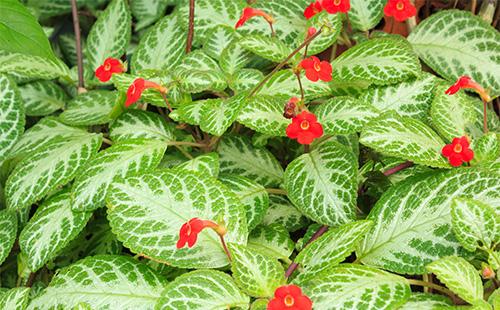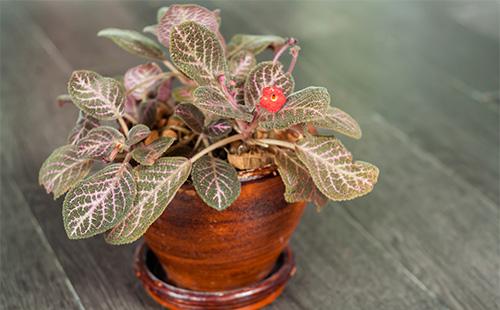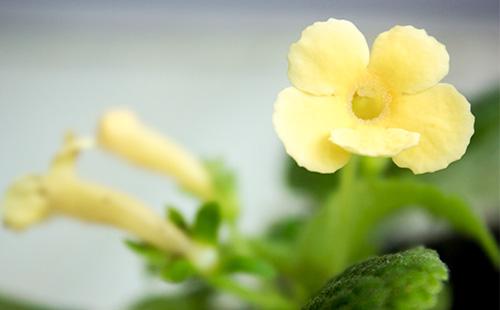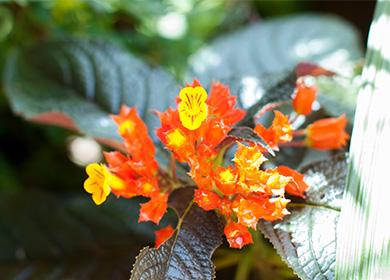The content of the article
The tropical rainforests of Central and South America are the native habitat of the establishment, which is comfortable under the crowns of tall trees. The plant with tropical charm surprises not only with its exclusive foliage, but also with the color of the flowers: lavender-blue, lilac, striped-cream, bright red, snow-white, golden-orange. Another feature of the Tropicana is mustache (long, leafless shoots), with their help the flower multiplies.
Varieties and their features
Perennial ampelous plant belongs to the Gesneriev family, has up to four dozen varieties. Four types are especially popular in indoor floriculture. These are descriptions with two different characteristics: with long shoots or shortened stems.
- Episcia cupreata (copper grade). The most common type of home recording. Recognizable by oval, copper-green leaves with light velvety and silvery blotches. Their length is up to 12 cm. Hybrid varieties are derived: Neptune (brown edges of leaves, red flowers) and Tropical topaz (yellow color of flowers).
- Episcia dianthiflora (description of clove). The size of the leaves is smaller than that of the previous variety. They are round in shape, pleasantly fluffy, green in color with red veins or a white and blue tint. Snow-white petals on the edges are decorated with a fringe and look like cloves. This very beautiful variety is often found on home windowsills.
- Episcia lilacina (lilac description). Bronze-green, ten-centimeter leaves and delicate flowers of lilac color with a yellow center and lilac border are characteristic.
- Episcia reptans (description creeping). This type of room decor is distinguished by creeping, velvety foliage in olive tones. Bright color spot - red flowers.
Episode Care and the "Secrets" of Healthy Growing
The name of this herb in Greek is “shaded”. This fundamental factor must be taken into account when choosing the location of the description. Beautifully hanging air sockets look spectacular in a cache-pot. A group of plants can become part of the design of the apartment, if you place the flowerpots or hanging pots in the back of the room under the soffits. But no less pleasing to the eye is its flowery and neat flowering bushes on the windowsill. Several contrasting varieties will look elegant in one pot. The main thing is to choose plants with approximately the same growth rate. So, how to care for the description?
Lighting
A tropical beauty will like a bright place, protected from direct sunlight, but it will develop normally in partial shade. If the light of the description is not enough, it will stop flowering, stretch unnaturally, turning graceful stems into long lashes. In addition, a deficiency of light affects immunity, the flower becomes sensitive to waterlogging of the soil. With excessive lighting, the plant will not give a mustache, its growth will slow down. The optimal location is east and west windows. In winter, additional lighting is required.
Comfortable temperature
The heat-loving episcia year round loves the high temperature + 22-27 ° C. This factor should be especially taken into account in the autumn and spring months when central heating is turned off. On winter days, temperatures of + 19 ° C are permissible, but at + 16 ° C and lower the plant may die. In summer, a flower pot with an description can be put on the balcony or terrace, protecting from the sun. Afraid of drafts.
Air humidity
Descriptions like humidity, and the higher it is, the more comfortable the flower feels. An optimum humidity level of 60% can be achieved in the following ways.
- Make an expanded clay layer. Put the pot in the pots 5 cm larger in diameter. At the bottom of the pots you need to make a "pillow" of small expanded clay and moisten it constantly. Water should not reach the bottom of the pot.
- Use sphagnum. The space between the pot and flower pots is filled with sphagnum. This layer must be maintained in a wet (not wet) state. Peat moss should be sprayed regularly enough.
- Organize “neighbors” with increased transpiration. It may be described in a company with plants that have the ability to evaporate water from the surface of a leaf.
- Place the plant near the aquarium. Or use a humidifier.
Watering
By and large, the description is not too demanding on the watering regime. She can calmly react to fluctuations in soil moisture, but it’s better not to allow extremes and adhere to the three main rules.
- Regularity. In summer, the flower is watered abundantly two to three times a week. Before each watering, check the level of dryness of the topsoil. The soil must have time to dry. In winter, hydration is reduced to moderate.
- Methodology Watering the plant, do not allow drops to fall on the leaves and flowers. Use slightly warm and necessarily settled water.
- Amount. During irrigation, the soil in the pot is wetted abundantly. After half an hour, excess water is drained from the pan to avoid decay of the root system.

Transplantation
The transplantation time is spring, and the frequency is every two years. A new pot should be 4-5 cm more spacious than the previous one. The shape of the planting capacity is chosen, taking into account the structural features of the flower. Convenient for growing shallow dishes - dishes with drainage holes. It is not difficult to transplant the epistemy into another pot, if you follow the technology, which includes the following eight steps.
- Water the plant well 30 minutes before transplanting. Then the earthen lump is removed easily.
- Carefully remove the flower.
- Free the roots from the old soil.
- Inspect the root system, remove dry or rotten roots.
- Treat the cut points with activated carbon powder.
- Wash a new pot with soapy water and pour over boiling water.
- Put drainage (2 cm layer) on the bottom.
- Cover the plant with freshly prepared soil (light and loose).
Soil substrate
The easiest way is to buy ready-made soil for violets or a universal soil for flowering plants in a flower shop, adding a little garden or turf soil to it. To prepare the substrate yourself, you need to take one part of peat and river sand and two parts of leafy soil. Charcoal or sphagnum moss can be added to this composition.
Supplementary Nutrition
To improve growth, a tropical plant is fed twice a month in spring and summer. They make complex liquid fertilizers for indoor flowers (mineral and organic). Dosage - two to four times less than the norm specified in the instructions. Caring for an episode during the flowering period (from early spring to late autumn) also involves systematic top dressing. In the autumn and winter months, the plant does not need additional nutrition.
Plant formation
With good content, the episode grows very quickly. To make the bush look neat and harmonious, you need to trim it. Shorten the stems to your taste after flowering. Young shoots are cut and planted back in a pot to form a curvaceous. To preserve a well-groomed appearance of an epistemology, they regularly get rid of wilted flowers and yellow, dry leaves.

Pest of pesticides ...
For many parasitic insects, the description is not of particular interest. However, aphids are potentially dangerous, mealybug, spider mite, root nematode. In the first three cases, the plant is treated with a soap solution or insecticide preparations. The treatment is repeated after a couple of weeks.
Root nematodes - microscopic worms that simultaneously damage the root system and the upper part of the flower - pose a significantly greater danger. The treatment is radical and is carried out in three steps.
- Trim healthy cuttings for growing in new soil.
- Discard the pest affected plant along with an earthen lump.
- Disinfect the pot.
... and diseases
Absolutely all the signs of the disease are associated with improper care, namely:
- roots rot, leaf structure changes - violation of irrigation rules, excess light;
- the epithesis does not bloom - mismatch of temperature;
- brown spots appear on the sheets - the result of watering with too cold water;
- leaves turn yellow - the negative effects of direct sun, an excess of fertilizers, low humidity;
- powdery mildew arose - sharp fluctuations in temperature and humidity, room ventilation, old, impoverished soil.

How to propagate
The main options for breeding a flower are considered to be cuttings and the leaf method. Less commonly, flower growers resort to seed propagation of an epistemosis.
- Cuttings. Rooting shoots is the most popular way of planting an appetite. To do this, cuttings are immersed in a container of water. The shoots with new roots are moved into the moist soil to a depth of 2-3 cm. You can simply shoot the shoots into the next pot without cutting them from the flower.
- Mustache. Mustache propagation can be done in spring. On leafless mustaches, young rosettes develop. To root the "children" of the description, use a mixed composition of peat and sand. After the appearance of the roots, the outlet is cut off from the adult plant and transferred to a permanent place.
- By sheet. The description of the leaf propagation is as follows: the cut sheet is instilled, dipped a little in the soil and the container is covered with cellophane, glass or a lid to create a greenhouse effect. Every three days, the greenhouse is opened for ventilation. When propagated by a leaf, the plant will bloom only in the second year.
In all three cases, rooting of the sprouts begins in a week. The main thing is to maintain a thermal regime of + 23-25 ° С.
Growing a description at home is beyond the reach of even a novice. To preserve the luxurious decorativeness of the leaves and the beauty of the flowers of a bright exotic plant, you need to follow simple recommendations. Then the whole year the episcia will decorate the room, giving it homeliness. By the way, observe how the velvety surface of the leaves, when changing the lighting, begins to magically sparkle with silver.
Reviews: "Kids" are growing by leaps and bounds "
I have an episcia has found a place for itself. In the room, the leaves turned yellow, and on the kitchen shelf was just a beauty. You can slightly increase watering, but do not overdo it. In general, by observation method you will find the “golden mean”.
Antonina, http://www.fialkovod.ru/forum/forum48/topic6573/
The variety of descriptions is very large and all are very beautiful with a varied color of leaves. Unfortunately, only one is growing. Chocolate velvet (velveteen) is the so-called translation of the variety of essay, which has been growing in my house for several years. I bought a shoot of a plant at the Bird Market. It does not give me much trouble. It grows on the east window among other flowers. Moderate watering and top dressing. Previously, the description was in a hanging pot, but I cut it and transplanted it into a pot, since on the windowsill you can better see the beauty of its wonderful leaves (photo). The leaves are dark brown, cast in the sun, blooms with bright pink small flowers. Propagated quite simply by side outlets, of which a lot are formed. I highly recommend paying attention to this wonderful plant, which can often be found in flower shops.
Svetlana Yuryevna, https://irecommend.ru/content/shokoladnyi-barkhat
The descriptions are good because they grow quickly. So, they can be updated annually. I put my grown-ups in the autumn on shelves, where they stand until they lose their "presentation", after which, after tearing 2-3 "kids" out, they mercilessly throw them away And the kids don’t take up much space, and in the spring they go back to the balcony where they grow like yeast.
Ne-Podarok, http://frauflora.ru/viewtopic.php?t=680

